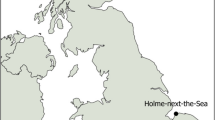Abstract
This paper examines the question of the nutritional value of cannibalism. Although other authors have concluded that the practice does not have such value, we argue that this cannot properly be determined except in the context of the total subsistence economy and local human ecology. The paper also presents a format for the empirical investigation of foodgetting and new ethnographic information about New Guinea cannibalism. Our major conclusion is that this practice does have nutritional value for certain human groups, specifically tropical peoples living at lowmedium population densities and exploiting a diverse range of animal foods.
Similar content being viewed by others
References
Bailey, K. V. (1964). Nutritional oedema in the Chimbu (New Guinea Highlands).Trop. Geog. Med. 16(1): 33–42.
Bailey, K. V., and Whiteman, J. (1963). Dietary studies in the Chimbu.Trop. Geog. Med. 15(4): 377–388.
Berndt, R. M. (1962).Excess and Restraint: Social Control Among a New Guinea Mountain People, University of Chicago Press, Chicago.
Bressani, R., and Behar, M. (1964). The use of plant protein foods in preventing malnutrition. InProceedings of the Sixth International Congress of Nutrition, Edinburgh, pp. 181–206.
Buchbinder, G. (1970). Personal communication, April.
Clarke, W. C. (1968). The Nduimba Basin, Bismarck Mts., New Guinea: Place and people. Unpublished doctoral dissertation in geography, University of California, Berkeley.
Dornstreich, M. D. (1973). An ecological study of food-getting: The Gadio Enga of New Guinea. Unpublished doctoral dissertation in anthropology, Columbia University, New York.
Fonaroff, L. S. (1965). Was Huntington right about human nutrition?Ann. Ass. Am. Geographers 55: 365–376.
Garn, S. M. and Block, W. D. (1970). The limited nutritional value of cannibalism.Am. Anthropologist 72(1): 106.
Glasse, R. (1967). Cannibalism in the Kuru region of New Guinea.Trans. N.Y. Acad. Sci. Ser. II 29(6): 748–754.
Harris, M. (1966). The cultural ecology of Indian sacred cattle.Curr. Anthropol. 7(1): 51–59.
Hipsley, E. H., and Kirk, N. H. (1965). Studies of Dietary Intake and the Expenditure of Energy by New Guineans, South Pacific Commission Technical Paper No. 147, Noumea, New Caledonia.
Hoad, R. A. (1964). Nomad River Patrol Report No. 4, 1963/64, Western District East Strickland Division, Nomad River, Administration of the Territory of Papua/New Guinea.
Kirk, M. S. (1969). Journey into stone age New Guinea.Nat. Geographic 135(4): 568–592.
Koch, K. F. (1968). On “possession” behavior in New Guinea.J. Polynesian Soc. 77(2): 135–146.
Koch, K. F. (1970). Cannibalistic revenge in Jale warfare.Nat. Hist. 79(2): 40–51.
Levins, R. (1966). The strategy of model building in population biology.Am. Scientist 54: 421–431.
Ma, M. H., Blackburn, C. R. B., McGovern, N. J., Burchett, P., and Arter, W. J. (1968). Liver disease in the Territory of Papua/New Guinea.Trop. Med. Geog. 20(4): 307–316.
Morren, G. E. B. (1973). The strategy of hunting and settlement: The ecology of the Miyanmin of New Guinea. Unpublished doctoral dissertation in anthropology, Columbia University, New York.
Neville, R. T. (1957). Telefomin Patrol Report No. 4, 1956/57, Patrol to the Miyanmin area, West Sepik District, Territory of Papua/New Guinea.
Oomen, H. A. P. C. (1961). The nutritional situation in Western New Guinea.Trop. Med. Geog. 13: 321–335.
Protein Requirements (1965). Report of a Joint FAO/WHO Expert Group (FAO Nutrition Meetings Report Series No. 37), WHO Technical Report Series No. 301, FAO of the United Nations, Rome.
Randall, M. E. (1971). Comment on “the limited value of cannibalism”.Am. Anthropologist 73: 269.
Rappaport, R. A. (1968).Pigs for the Ancestors: Ritual in the Ecology of a New Guinea People, Yale University Press, New Haven.
Recommended Dietary Allowances (1968). Report of the Food and Nutrition Board of the National Research Council, National Academy of Science, 7th ed.
Roberts, D. F. (1956). A demographic study of a Dinka village.Hum. Biol. 28: 323–349.
Schneider, H. K. (1957). The subsistence role of cattle among the Pakot and in East Africa.Am. Anthropologist 59: 278–300.
Serpenti, L. M. (1965).Cultivators in the Swamps: Social Structure and Horticulture in a New Guinea Society, Van Gorcum, Assen.
Shankman, P. (1969). Le roi et le bouille: Levi-Strauss' theory of cannibalism.Am. Anthropologist 71(1): 54–69.
Simpson, C. (1953).Adam with Arrows, Angus and Robertson, Sydney and London.
Sinclair, J. P. (1966).Behind the Ranges: Patrolling in New Guinea, Cambridge University Press, London and New York.
South Pacific Post articles (1968). “Fight leaders in weapon exchange” and “Civilization comes to the Biami area,” September 27.
Suttles, W. (1960). Affinal ties, subsistence and prestige among the Coast Salish.Am. Anthropologist 62: 296–305.
Vayda, A. P. (1961). A re-examination of Northwest coast economic systems.Trans. N.Y. Acad. Sci. Ser. II 23(7): 618–624.
Vayda, A. P. (1970). On the nutritional value of cannibalism.Am. Anthropologist 72: 1462–1463.
Vayda, A. P., Leeds, A., and Smith, D. (1960). The place of pigs in Melanesian subsistence. InActes du VI Congres International des Sciences Anthropologiques et Ethnologiques, Paris, Vol. III, pp. 1653–1658.
Venkatachalam, P. S. (1962).A Study of the Diet: Nutrition and Health of the People of the Chimbu Area (New Guinea Highlands), Department of Public Health Monograph No. 4, Territory of Papua/New Guinea.
Wagner, R. (1967).The Curse of the Souw: Principles of Daribi Clan Definition and Alliance, University of Chicago Press, Chicago.
Walens, S., and Wagner, R. (1971). Pigs, proteins and people-eaters.Am. Anthropologist 73: 269–270.
Zimmer, G. F. W. (1969). When the Kukukukus came from the hills, it was to kill.Pacific Islands Monthly 40(11): 85–93.
Author information
Authors and Affiliations
Additional information
The ethnographic information reported in this paper was collected among the Gadio and Miyanmin peoples while the authors were engaged in dissertation fieldwork in New Guinea during 1967–1968. Support for this research was provided by the following grants: NSF-GS-1795, Task I (M. D.), Task II (G. M.), Principal Investigator, Professor A. P. Vayda; NSF Graduate Fellowship (G. M.); Fulbright-Hays Act Fellowship (M. D.); Department of Anthropology, Columbia University (M. D.).
Rights and permissions
About this article
Cite this article
Dornstreich, M.D., Morren, G.E.B. Does New Guinea cannibalism have nutritional value?. Hum Ecol 2, 1–12 (1974). https://doi.org/10.1007/BF01507342
Received:
Revised:
Issue Date:
DOI: https://doi.org/10.1007/BF01507342




